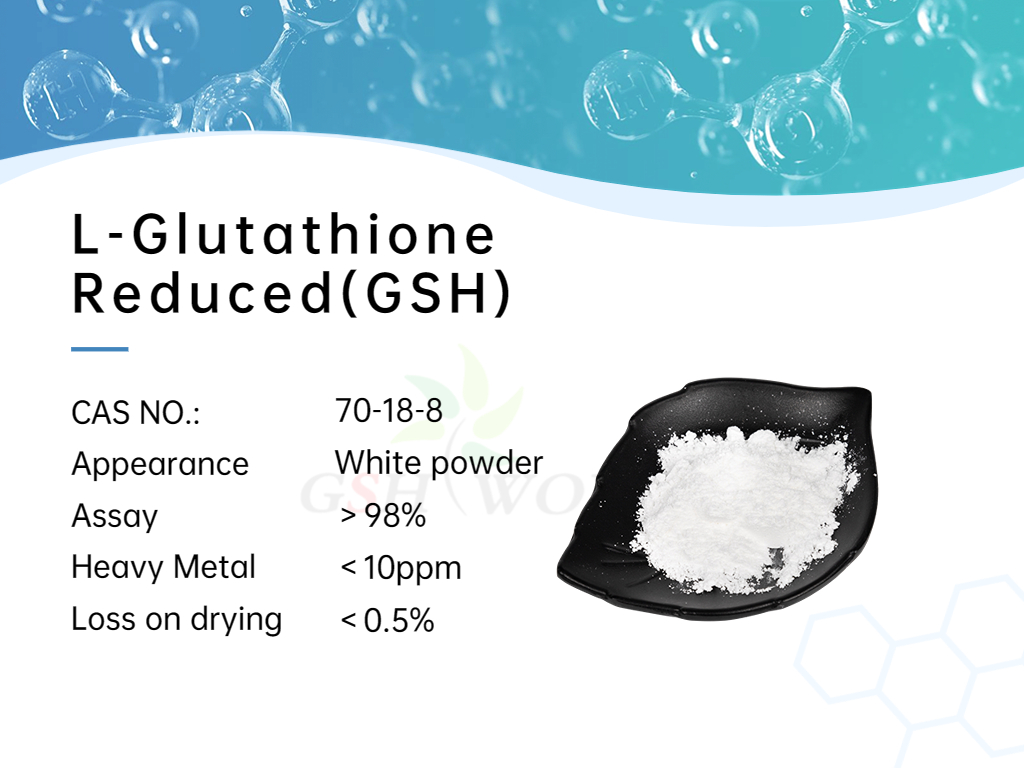Physiological functions of reduced glutathione
by: GSHWORLD
time: 2023-08-04
classify: Product News
Reduced glutathione, that is, γ-glutylcysteinylglycine, as a non-protein sulfhydryl molecule, has a strong ability to donate electrons or proton hydrogen. As a coenzyme of specific enzymes, glutathione has the functions of scavenging free radicals, modifying proteins, protecting proteins and enzymes containing sulfhydryl groups in cell membranes from oxidation, catalyzing disulfide bond exchange reactions, and signal transduction.

These characteristics of glutathione determine that it plays an important physiological role in organisms, such as anti-oxidative stress, detoxification, elimination of inflammation, anti-radiation damage, participation in the transport and absorption of amino acids, anti-aging effects, etc.
Physiological functions of glutathione
1. Antioxidant
The antioxidant function of GSH mainly relies on enzymatic pathways involved in cellular defense against reactive oxygen species (ROS). Two molecules of GSH can be oxidized to one molecule of GSSG under the action of glutathione peroxidase GPX, and at the same time, the toxic aerobic metabolite peroxide can be reduced to a non-toxic hydroxyl compound, thereby protecting the structure and function of the cell membrane Free from interference and damage from peroxides. GSSG is reduced to GSH under the action of glutathione reductase, and at the same time oxidizes NADPH to NADP+, thereby forming a redox cycle to avoid oxidative damage. This cycle of interconversion enables the continuous elimination of free radicals in cells. In addition, yeast cells can also deploy more NADPH to promote the chemical reaction between ROS and O2 and the paired GSH. When GSH is oxidized to GSSG, ROS and O2 are reduced, so as to better cope with oxidative stress.
2. Detoxification and detoxification
Glutathione is the unique substrate of glutathione peroxidase and glutathione S-transferase GST, and is the core of a complex multifaceted detoxification enzyme system. Its detoxification function is mainly through these two enzymes to complete. GSH provides reducing power for a variety of reactions, and plays a key role in the detoxification reactions of free radicals such as hydrogen peroxide, superoxide, and unimolecular oxygen. Accelerates the metabolism of free radicals. Glutathione can not only scavenge ROS, but also has a defensive function against toxic downstream products. In addition, GSH can also help metabolize exogenous toxic substances. In the detoxification process of a variety of exogenous substances (including drugs) that interact with tripeptides, the exogenous toxic substances are first oxidized by the hepatic cytochrome P-450 metabolic enzyme system, and then GST catalyzes the GSH sulfhydryl group to covalently interact with the electrophilic compound. Binding, inactivating and increasing its solubility, and finally excreted in urine and feces in the form of thioether acid.
picture
3. Modulate immune response and control inflammation
GSH plays an important role in both innate immunity and acquired immunity. It can not only regulate the activity of neutrophils and dendritic cells, but also regulate the proliferation and activity of T cells. Th cells are helper T cells, which differentiate into Th1 and Th2 cells under the stimulation of antigen peptides provided by antigen-presenting cells and the induction of different cytokines. Th1 cells mainly mediate immune responses related to cytotoxicity and local inflammation, assist antibody production, and participate in cellular immunity and delayed hypersensitivity inflammation, while Th2 cells can assist B lymphocytes to differentiate into antibody-secreting cells and participate in humoral immune responses. GSH levels control Th1/Th2 balance by modulating cytokine patterns and the cellular environment of antigen-presenting cells. GSH depletion leads to a dominant Th2 response, suppresses lymphocyte CD8+ and cytotoxic lymphocyte function, and activates CD4+ T lymphocytes, leading to inflammatory/immune-mediated diseases.
4. Regulating protein function
In addition to providing a reducing environment for cells and maintaining proteins in a reduced state, more and more evidence shows that GSH can also modify and regulate protein functions. GSH can convert S-nitrosylated cysteine residues and sulfate to relatively stable mixed disulfides. High-performance liquid chromatography analysis showed that more than 85% of the protein S-thiolation reaction is bound to GSH, and this S-thiolation is specifically called S-glutamylation or S-glutathionylation modification . S-glutathionylation generally occurs at cysteine residues in proteins, which are usually located in the catalytic center of enzymes or at the junction of proteins and proteins, and reversibly combine with GSH to form mixed disulfides. Protein S-glutamylation can buffer the effects of oxidative stress, stabilize extracellular proteins, prevent irreversible oxidation of key protein cysteine residues, and control enzyme activity and transcription.
Although the proportion of S-glutathioneylated proteins in the proteome is not high, many S-glutathioneylated proteins found in animal cells have different important roles, mainly participating in carbohydrates Enzymes of various metabolic pathways of energy substances and certain types of cytoskeletal proteins, as well as related proteins of transcription and translation, protein folding, and free radical scavenging.
picture
5. Transmembrane transport of amino acids
A series of enzymatic reactions for the synthesis and utilization of glutathione is called the γ-glutamyl cycle. The γ-glutamyl cycle consists of six steps of enzyme-catalyzed reactions. Under the catalysis of γ-glutamyl transpeptidase on the outer side of renal cell plasma membrane, GSH transfers γ-glutamyl to acceptor amino acid and generates cysteinyl glycine. After that, the generated γ-glutamyl amino acid is reabsorbed by the cells of other organs under the action of γ-glutamyl cyclotransferase to generate the intermediate product 5-hydroxyproline, and release the transported free amino acid at the same time. 5-Hydroxyproline and ATP further generate glutamic acid under the action of 5-hydroxyprolinase, and then participate in the two-step synthesis reaction of GSH as a raw material, thus forming a cycle. The γ-glutamyl cycle is also one of the mammalian amino transport systems.
*Special note - This article is for informational purposes only and cannot replace a doctor's treatment diagnosis and advice. It should not be regarded as a recommendation or proof of efficacy of the medical products involved. If it involves disease diagnosis, treatment, and rehabilitation, please be sure to go to a professional medical institution to seek professional advice.

by GSHWORLD
GSHWORLD is China Biological API Manufacturer. China Glutathione Supplements powder suppliers & best Glutathione benefits raw material Factory.









